Champagne Taittinger
by
Kathy and Terry Sullivan
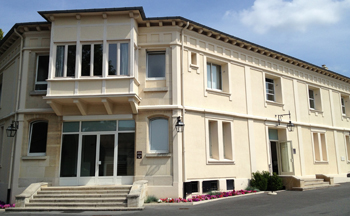 Summary: Champagne Taittinger is a large Champagne producer in Reims, France. They are also one of the oldest wine producers in the region. Visitors can register for a wonderful tour of the chalk caves located below the visitor center. We visited the champagne house in the summer of 2013 and again in April 2015.
Summary: Champagne Taittinger is a large Champagne producer in Reims, France. They are also one of the oldest wine producers in the region. Visitors can register for a wonderful tour of the chalk caves located below the visitor center. We visited the champagne house in the summer of 2013 and again in April 2015.
Visitors to Champagne Taittinger will discover a delightful experience that includes a large reception room. The spacious reception area is white with bright red notes. The bright room has plenty of space to spread out while tasting champagne.
Pierre Taittinger discovered the Champagne region during World War I. He had a passion for wine and gastronomy. Several years after the war, Pierre and his brother-in-law returned to Champagne and founded the Champagne business. Today Pierre-Emmanuel Taittinger with his son Clovis and daughter Vitalie run the family business.
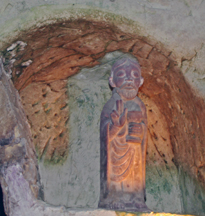 Saint Nicaise Abbey
Saint Nicaise Abbey
In the 13th century, monks built Saint Nicaise Abbey and the foundation of caves below it. Hewn out of chalk, the caves provided the ideal environment for wine storage and transportation to other areas of the city of Reims. Above ground, the Abbey fell victim to the winds of war. Below ground there was little damage, though. It is in these below ground caves, where monks once trod, that today’s winemakers and cellar masters keep a watchful eye over the champagnes.
Vineyards
Taittinger owns 288 hectares (over 711 acres) that cover 50 percent of their grape needs. The winery sources the remaining fruit from growers in Champagne with long-term contracts and several cooperatives. Grape varieties include Chardonnay that covers 38 percent of the vineyards. The largest vineyard planting is Pinot Noir with 48 percent of the vineyards. Pinot Meunier covers 14 percent of the vineyards. The 288 hectares produce 34 different crus. In Champagne, a cru is a village.
Over half of the vineyards are tilled several times from February to July. There are no herbicides used in the vineyards. Several local farmers plow the vineyards with horses. Taittinger owns three pressing centers. After harvesting the grapes, the grapes are pressed at one of these centers. There is a separate pressing for each cru and each variety. Light pressure is used in the pressing and the juice is clear. It is then fermented separately just as it was pressed separately. The still wines are tasted and then blended depending on whether the cellar team wants to make a non-vintage or vintage champagne, and based on what style of champagne the winery is making.
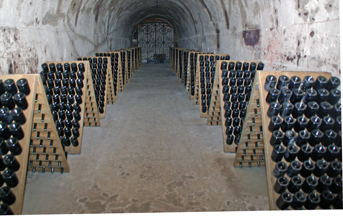 The Caves Tour
The Caves Tour
Catherine Bernier led our tour at Taittinger Caves during our first visit in 2013. She was professional and friendly and her English was wonderful for our English-speaking group. Our tour began with a short video that mentioned the history of the chalk and limestone caves and Taittinger’s history. Our tour in April 2015 began with a different movie. We then proceeded into the caves where we learned that the first level of caves is 12 meters (almost 40 feet) under ground. This level of caves dates from the 13th century. These caves connect to deeper caves built by the Romans in the 3rd century.
The deeper level is 18 meters (59 feet) underground. Roman quarries now age thousands of bottles of champagne. This is where some of their champagnes, including the Count of Champagne is aging. The Count of Champagne is always a vintage of blends from different villages. It is also a grand cru blanc de blanc.
In the 13th century, a group of monks constructed the caves for storing their barrels under the Abbey. The Abbey was destroyed during the French Revolution but the caves were not damaged.
The cave system, in addition to storing wine, was used by war ravaged inhabitants of the area as a place of refuge when under attack.
Taittinger owns additional properties including larger cellars in Reims.
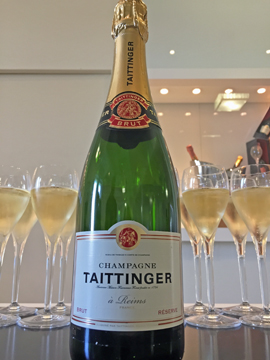 Champagnes
Champagnes
These champagne notes are from our April 2015 tasting. The Brut Réserve is a blend of Chardonnay 40%, Pinot Noir 35% and Pinot Meunier 25%. The yellow color wine had columns of beads forming a mousse on the surface. There were notes of apple, citrus and freshly baked bread.
Brut Réserve Haiku
Champagne Taittinger
Beads exploding aromas
Smiles celebrate
Our second champagne tasted was the 2005 Comtes de Champagne Blanc de Blancs. The blend is made from Chardonnays from vineyards in the Côte des Blancs. Only the first pressed cuvée is used to make the wine for this champagne. The yellow color champagne had small beads forming a mousse on the surface. The wine was creamy with hints of freshly baked bread and apples.
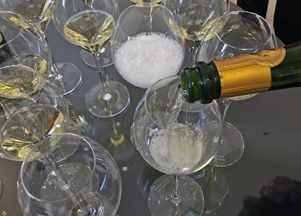 2005 Comtes de Champagne Blanc de Blancs Haiku
2005 Comtes de Champagne Blanc de Blancs Haiku
A 2005
Less fizz more aroma, taste
Some freshly baked bread
Wine Tourism
The cellars are open year round. Call to make an appointment.
Champagne Taittinger
9 place St. Nicaise
51100 REIMS, France
+33 3 26 85 45 35
Original article July 2013
Updated in April 2015
Visit these tour operators that partner with Wine Trail Traveler.
 |
||||
France
|
France
|
France | SmoothRed London, England, United Kingdom |


